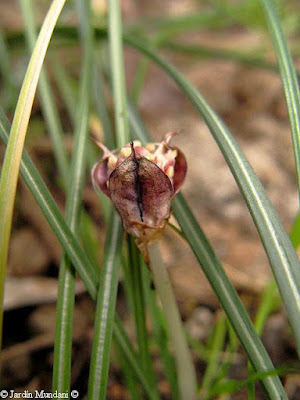Crocus cambessedesii is a small endemic plant of Majorca and Menorca from the Iridaceae family. Its flowers cheer the Balearic autumn with its six white, pink, bluish or dwelled tepals that look for the light of the sun as small satellite dishes and fills of color and life coastal rocks from the level of the sea to a height about 300 msnm. Usually it grows as much in clear rocky coastal garrigues with very little land as in cracks and concavities of rocks of mountainous slopes near the sea. Its habitat requires abundant light, constant humidity and a substrate of mosses and lichens that act as a sponge and retain the humidity of autumnal rains and the marine breeze that every morning covers with dew the coastal zones inland until several kilometers.
Crocus cambessedesii at the beginning of November growing in a small concavity of a calcareous rock on a substrate of moss of not more than 3 centimeters in thickness. The rock is very great and is stained by white, gray and black lichens that grow on its surface. In center it has a small concavity of about 30 centimeters of diameter with this gorgeous garden in miniature. The flowers are of the albino variety and shine with own light like small stars. I recommend to enlarge the photos with a double click to appreciate better the details.
This albino small flower has the bulb or corm in a vertical rocky crack in a clear of oak forest very shady. In order to catch the maximum of light it grows of pendular form with the tepals watching at the sun.
In this image we can see two Crocus cambessedesii each of them with its respective white flower with a slight pink dye like tiny satellite dishes following the trajectory of the sun. In its base they have a small rosette of filiform leaves. This photo was taken at the end of October. The flowers and the leaves are developed at the same time. In each bulb or corm a single flower emerges.
The two seen previous flowers from above. The six tepals of each flower form two series of three ones. The external ones are slightly greater and more tinted than the three interns. The tepals are united in their inferior part forming a long tube of about 7 - 12 centimeters that emerges directly from the ground from corm or bulb.
In this image also taken at the end of October a flower of Crocus cambessedesii can be seen with a beautiful very smooth pink color.
Here we can see another flower of Crocus cambessedesii with tepals slightly dwelled. In Majorca and Menorca this endemic plant receives the name " Safrà bord" , that is to say, wild saffron.
And finally the darkest color, between mulberry and celestial blue.
The three inferior tepals by their basal face display gorgeous dwelled lines with ramifications. Enlarging the photo with a double click is appraised better its beauty.
The flowers are hermaphrodite. They have stamens with yellow anthers loaded of pollen and three stigmata of an aliveorange red color, typical of all the Crocus, like those of worked saffron. The stigmata are ramifications of the long style that crosses the tube from the ovary, that at first is underground and it is divided in three branches around the tepals. After the fertilization and the maturation of the seeds the ovary is pushed upwards until showing outside the soil over the rosette of leaves.
The leaves of the Crocus cambessedesii are filiform with a white line that crosses the superior part of the leaf. Comparing them with the fingers its tiny size is appraised better.
After the fertilization the flower is dried and the underground ovary is maturing the seeds protected of the depredation of the herbivores. When the seeds are mature the ovary formed by three shells are pushed upwards until emerging from the soil and then it open and it disperses the seeds that are extraordinarily small. At the same time the leaves are dried and corm or bulb enters in estivation, hoping patiently that pass the lengths, droughts and torrid months of the Balearic summer. In the photo the white line is seen very well that crosses each leaf.
Fruit of Crocus cambessedesii with the three already empty shells after the dispersion of the seeds. If we compared with the yolk of the forefinger we make an idea of its tiny size.












No comments:
Post a Comment